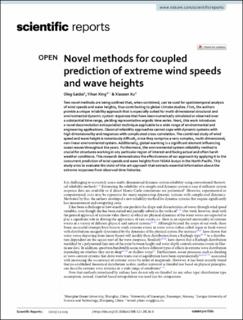| dc.contributor.author | Gaidai, Oleg | |
| dc.contributor.author | Xing, Yihan | |
| dc.contributor.author | Xu, Xiaosen | |
| dc.date.accessioned | 2023-11-28T09:35:15Z | |
| dc.date.available | 2023-11-28T09:35:15Z | |
| dc.date.created | 2023-01-21T10:00:47Z | |
| dc.date.issued | 2023 | |
| dc.identifier.citation | Gaidai, O., Xing, Y., & Xu, X. (2023). Novel methods for coupled prediction of extreme wind speeds and wave heights. Scientific Reports, 13(1), 1119. | en_US |
| dc.identifier.issn | 2045-2322 | |
| dc.identifier.uri | https://hdl.handle.net/11250/3104945 | |
| dc.description.abstract | Two novel methods are being outlined that, when combined, can be used for spatiotemporal analysis of wind speeds and wave heights, thus contributing to global climate studies. First, the authors provide a unique reliability approach that is especially suited for multi-dimensional structural and environmental dynamic system responses that have been numerically simulated or observed over a substantial time range, yielding representative ergodic time series. Next, this work introduces a novel deconvolution extrapolation technique applicable to a wide range of environmental and engineering applications. Classical reliability approaches cannot cope with dynamic systems with high dimensionality and responses with complicated cross-correlation. The combined study of wind speed and wave height is notoriously difficult, since they comprise a very complex, multi-dimensional, non-linear environmental system. Additionally, global warming is a significant element influencing ocean waves throughout the years. Furthermore, the environmental system reliability method is crucial for structures working in any particular region of interest and facing actual and often harsh weather conditions. This research demonstrates the effectiveness of our approach by applying it to the concurrent prediction of wind speeds and wave heights from NOAA buoys in the North Pacific. This study aims to evaluate the state-of-the-art approach that extracts essential information about the extreme responses from observed time histories. | en_US |
| dc.language.iso | eng | en_US |
| dc.publisher | Springer Nature | en_US |
| dc.rights | Navngivelse 4.0 Internasjonal | * |
| dc.rights.uri | http://creativecommons.org/licenses/by/4.0/deed.no | * |
| dc.title | Novel methods for coupled prediction of extreme wind speeds and wave heights | en_US |
| dc.type | Peer reviewed | en_US |
| dc.type | Journal article | en_US |
| dc.description.version | publishedVersion | en_US |
| dc.rights.holder | © The Author(s) 2023 | en_US |
| dc.subject.nsi | VDP::Matematikk og Naturvitenskap: 400 | en_US |
| dc.source.volume | 13 | en_US |
| dc.source.journal | Scientific Reports | en_US |
| dc.source.issue | 1 | en_US |
| dc.identifier.doi | 10.1038/s41598-023-28136-8 | |
| dc.identifier.cristin | 2112462 | |
| cristin.ispublished | true | |
| cristin.fulltext | original | |
| cristin.qualitycode | 1 | |

